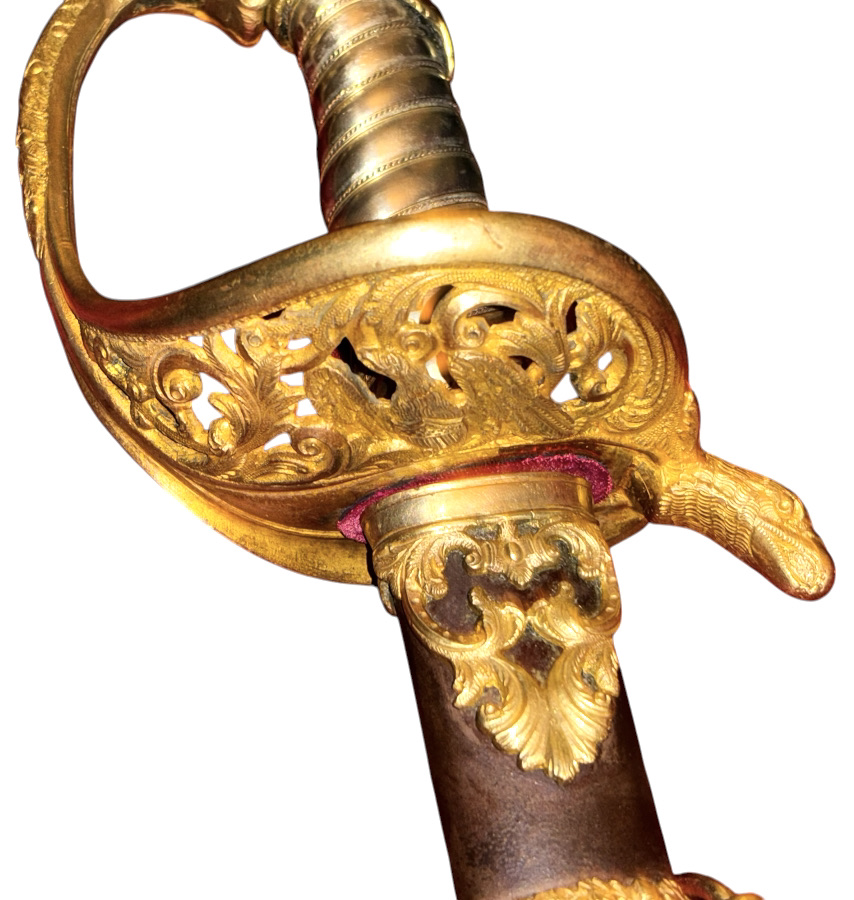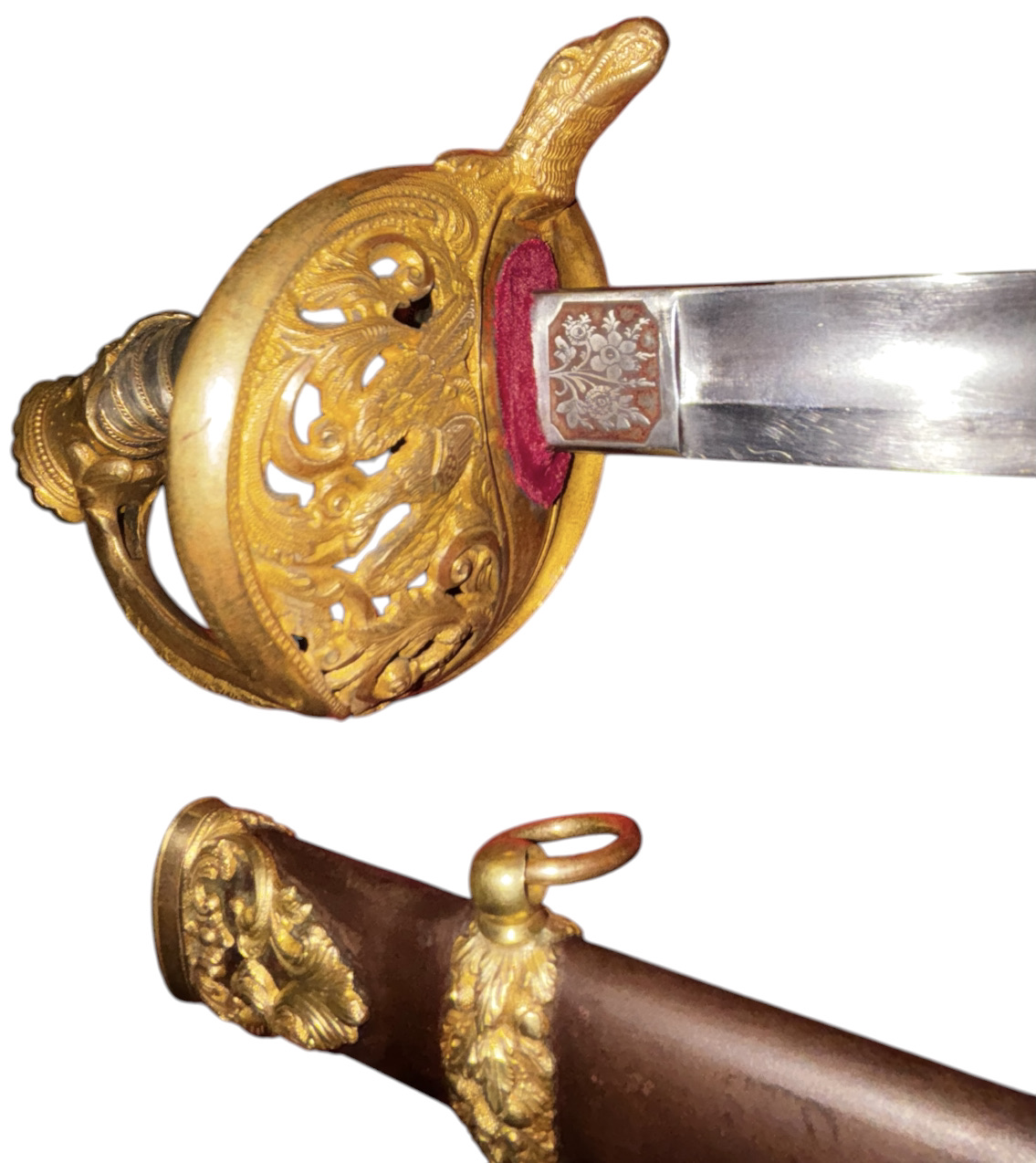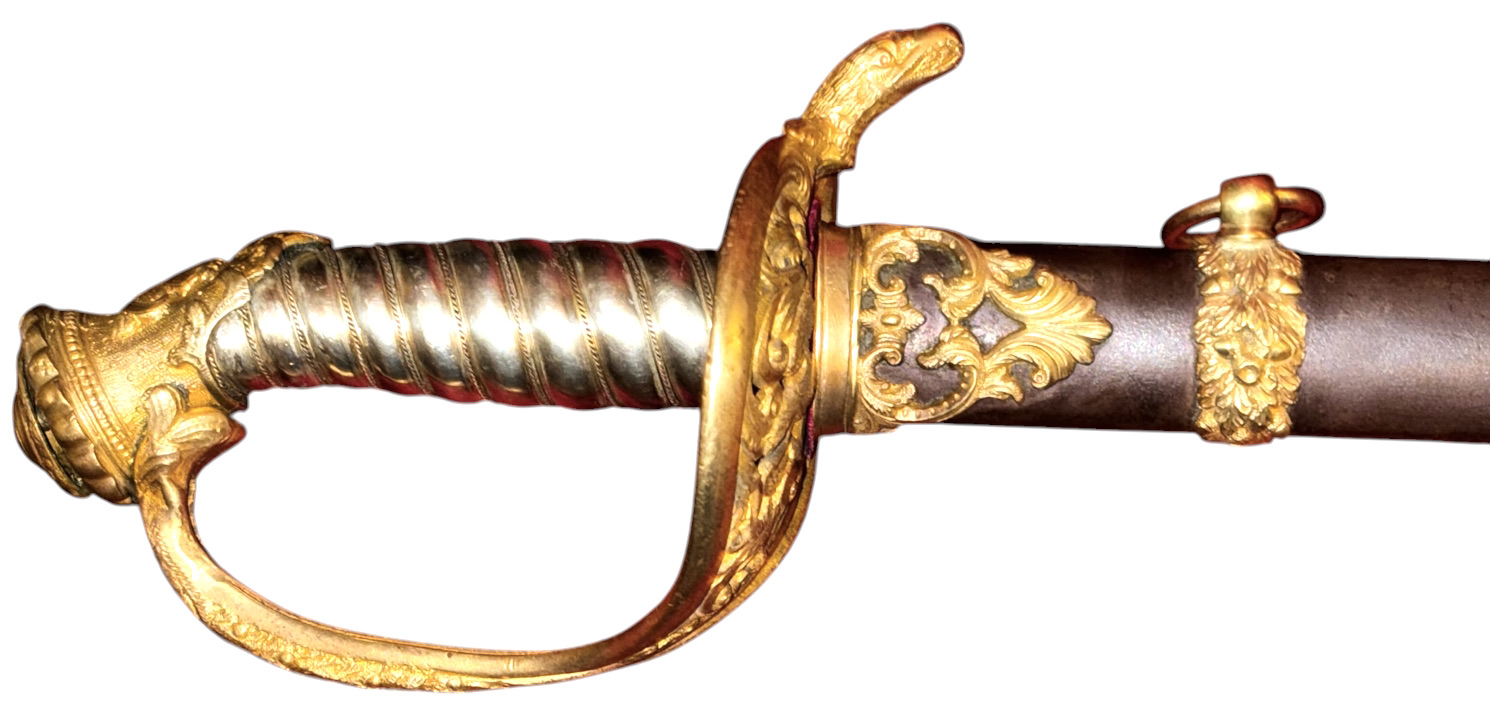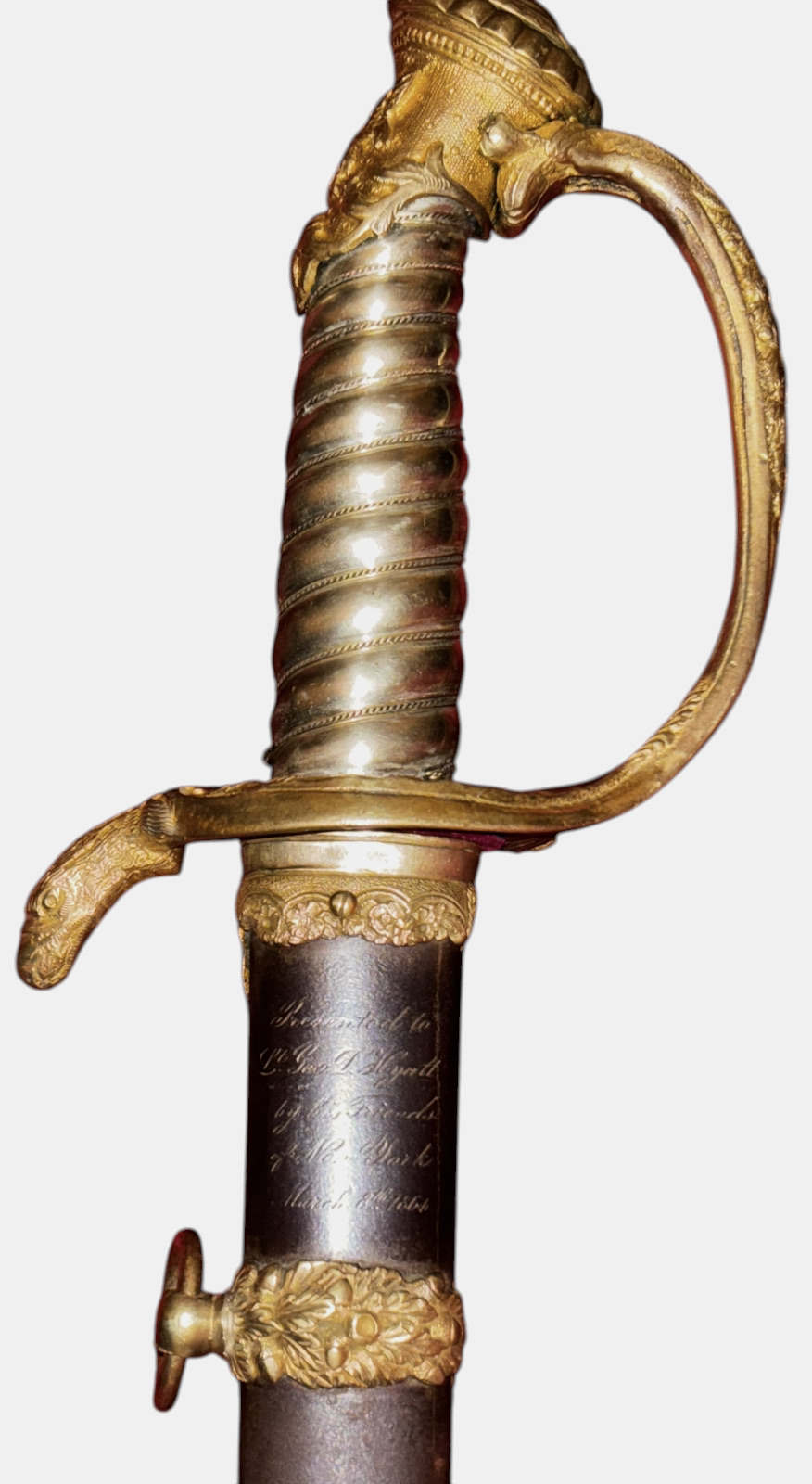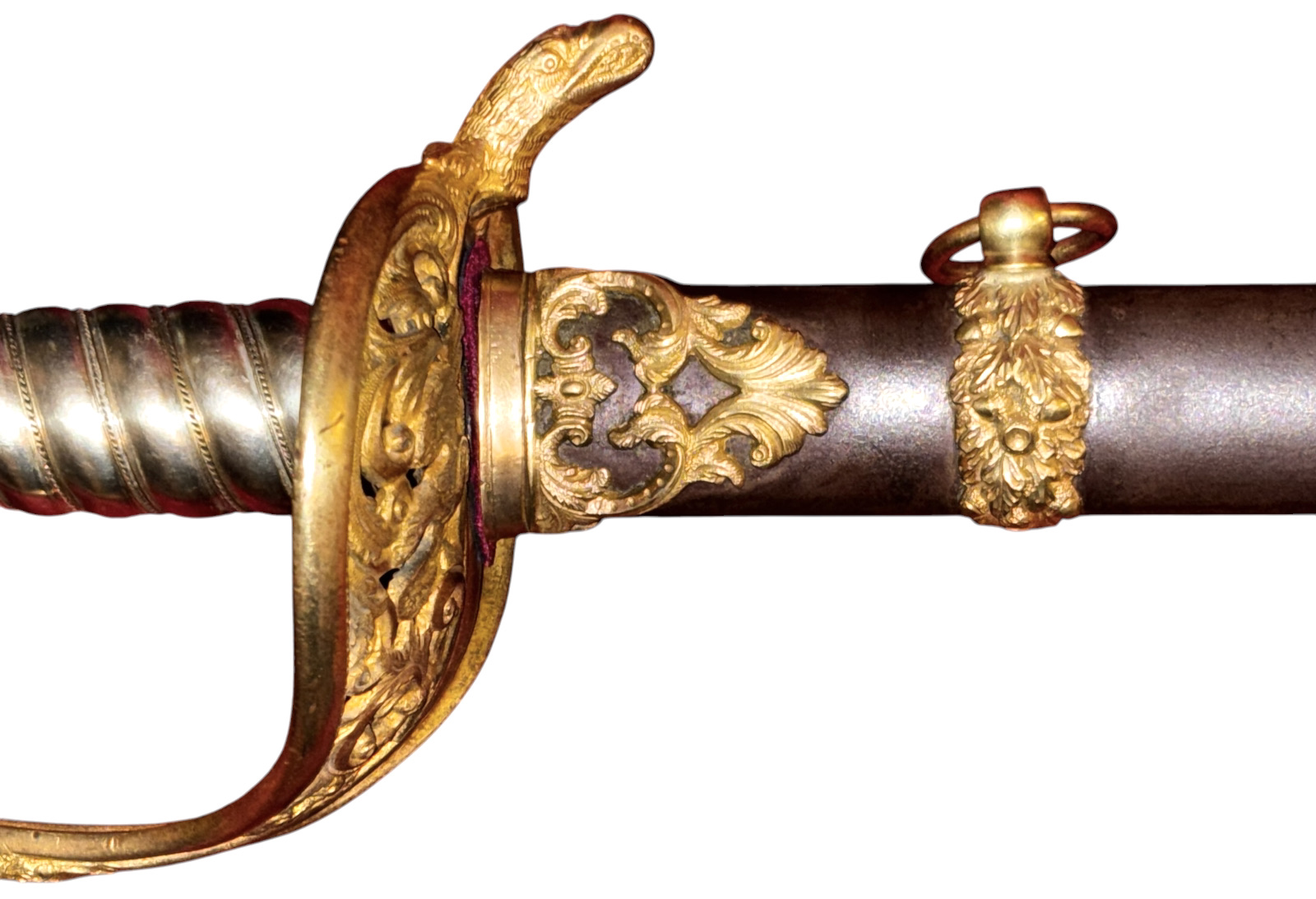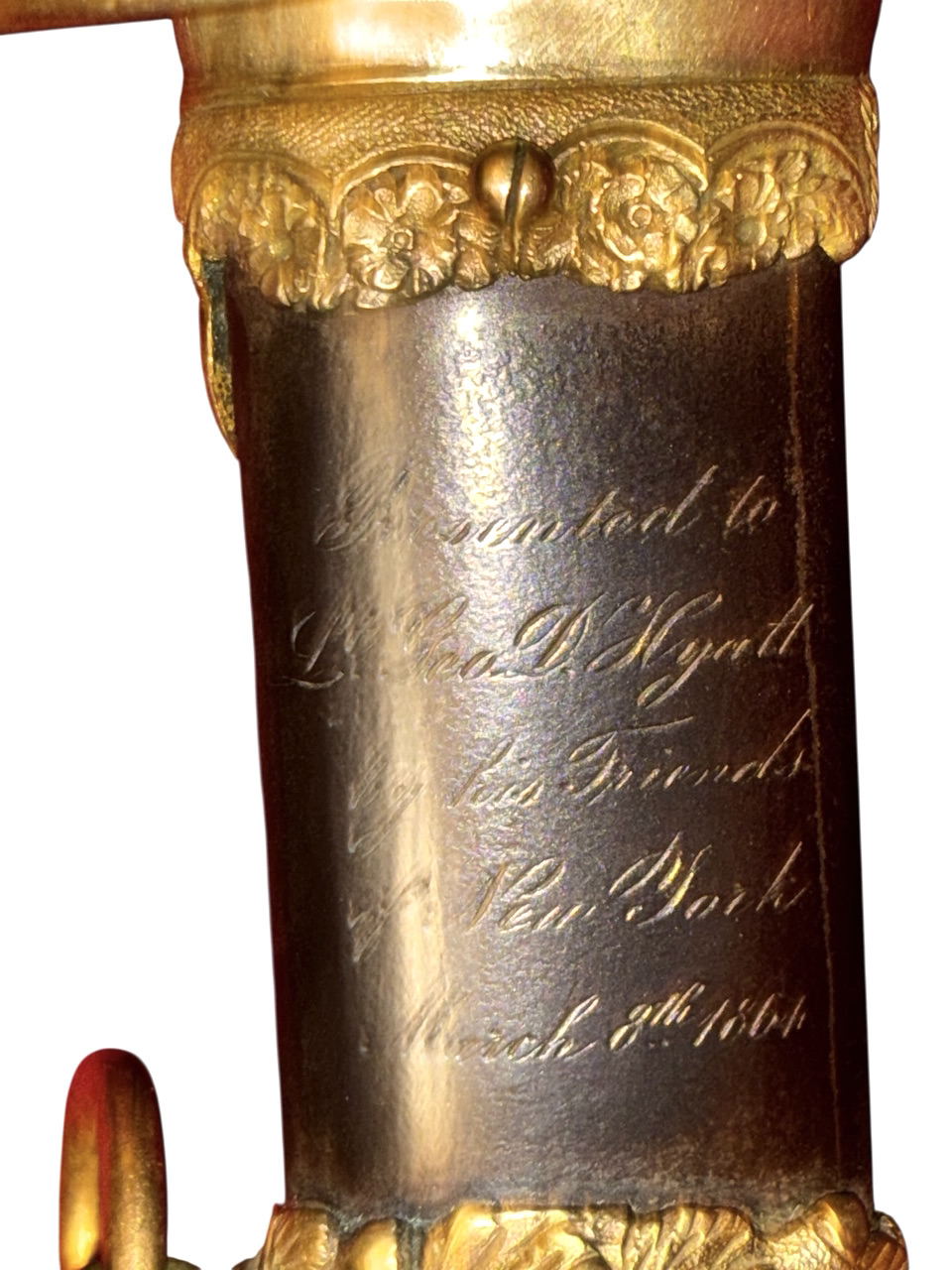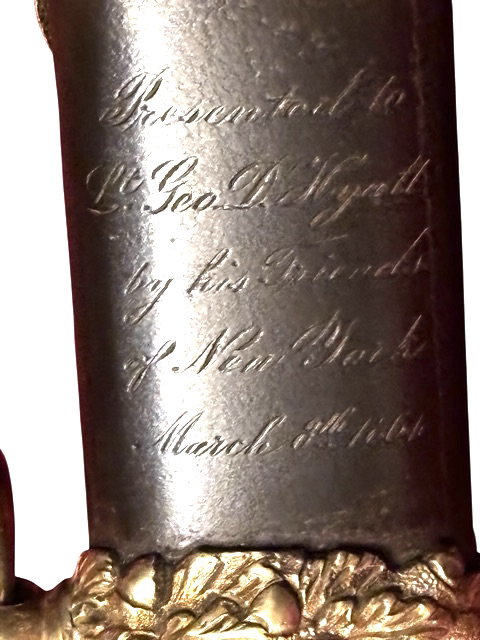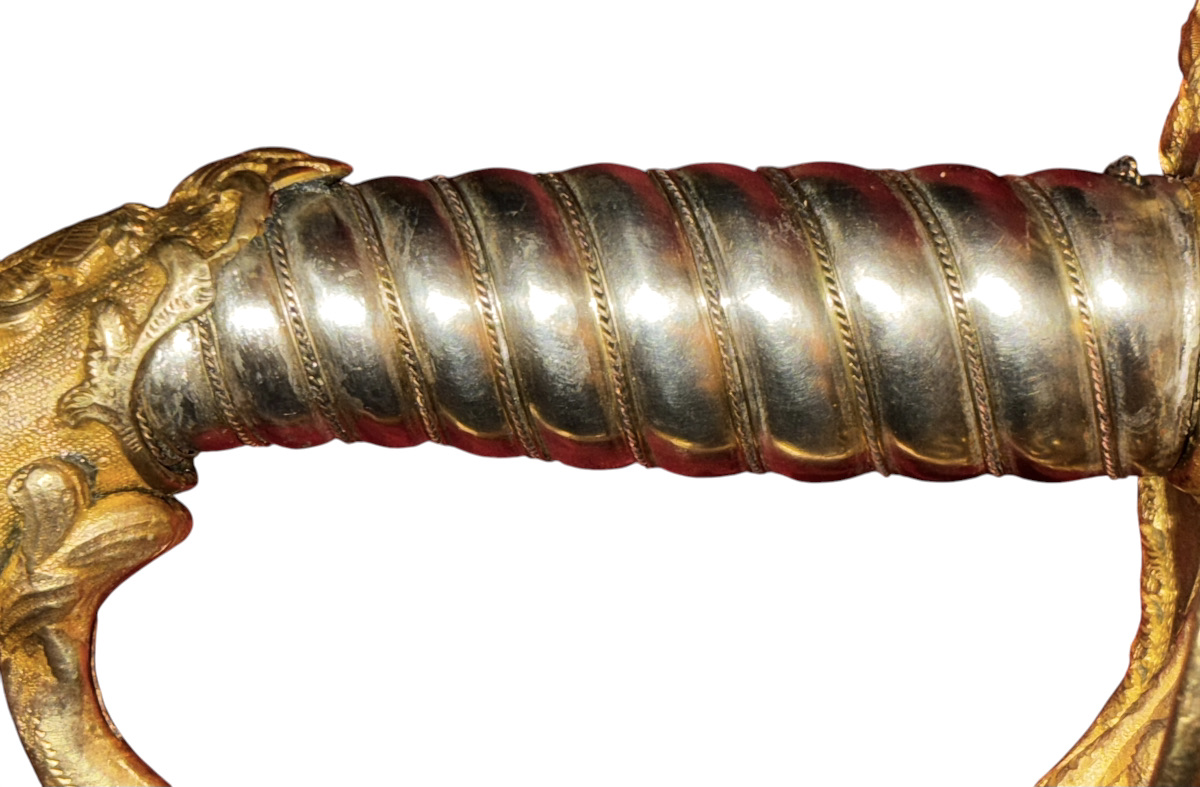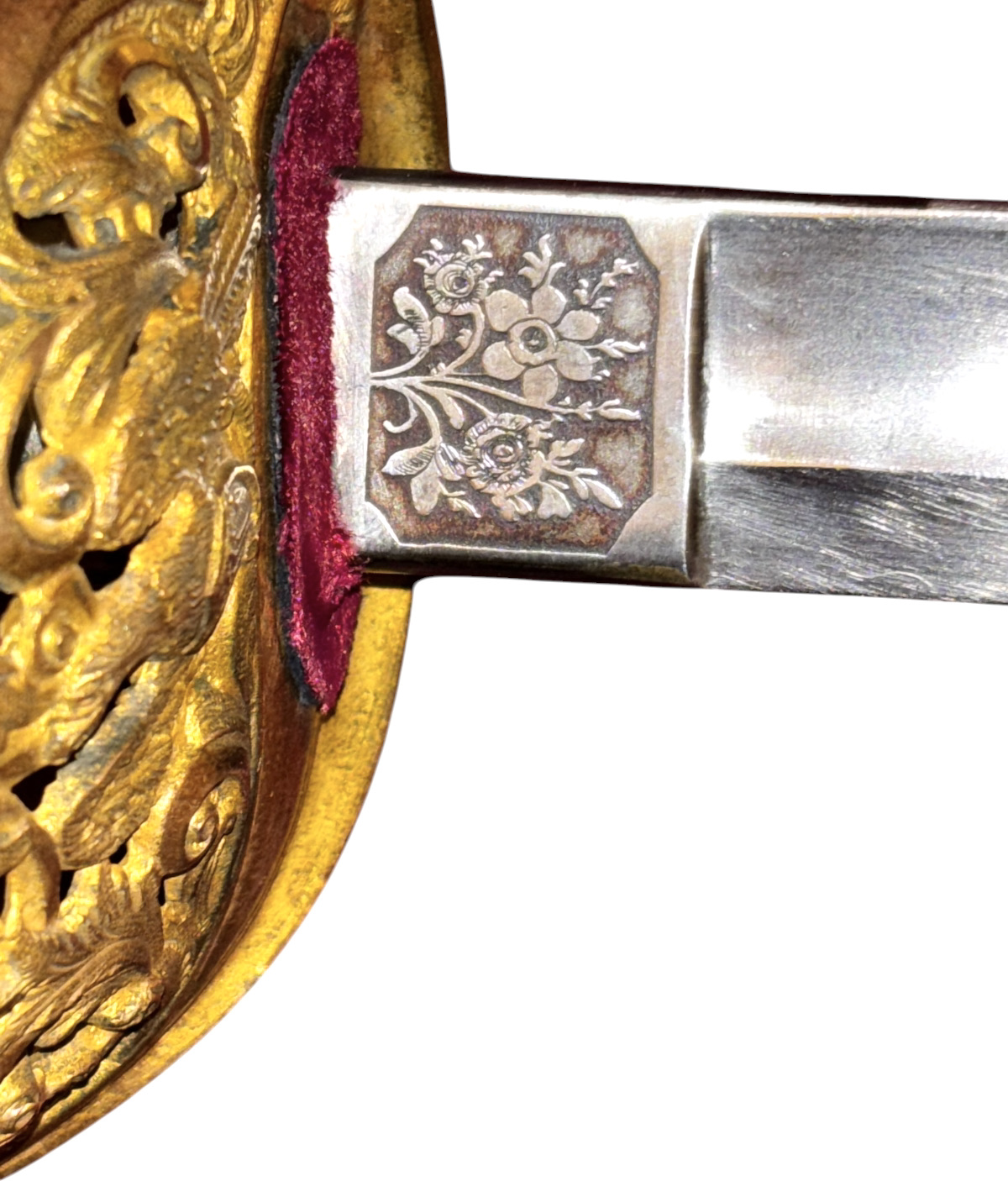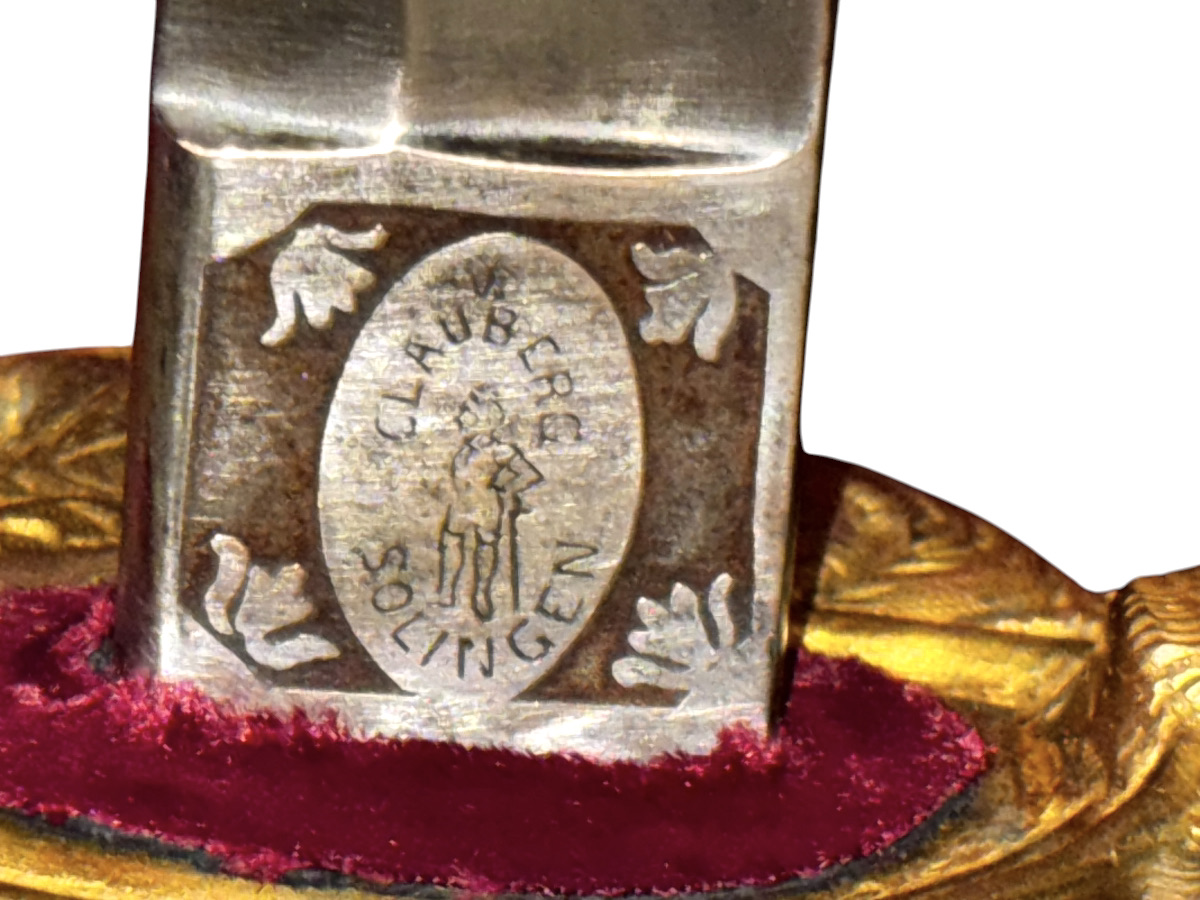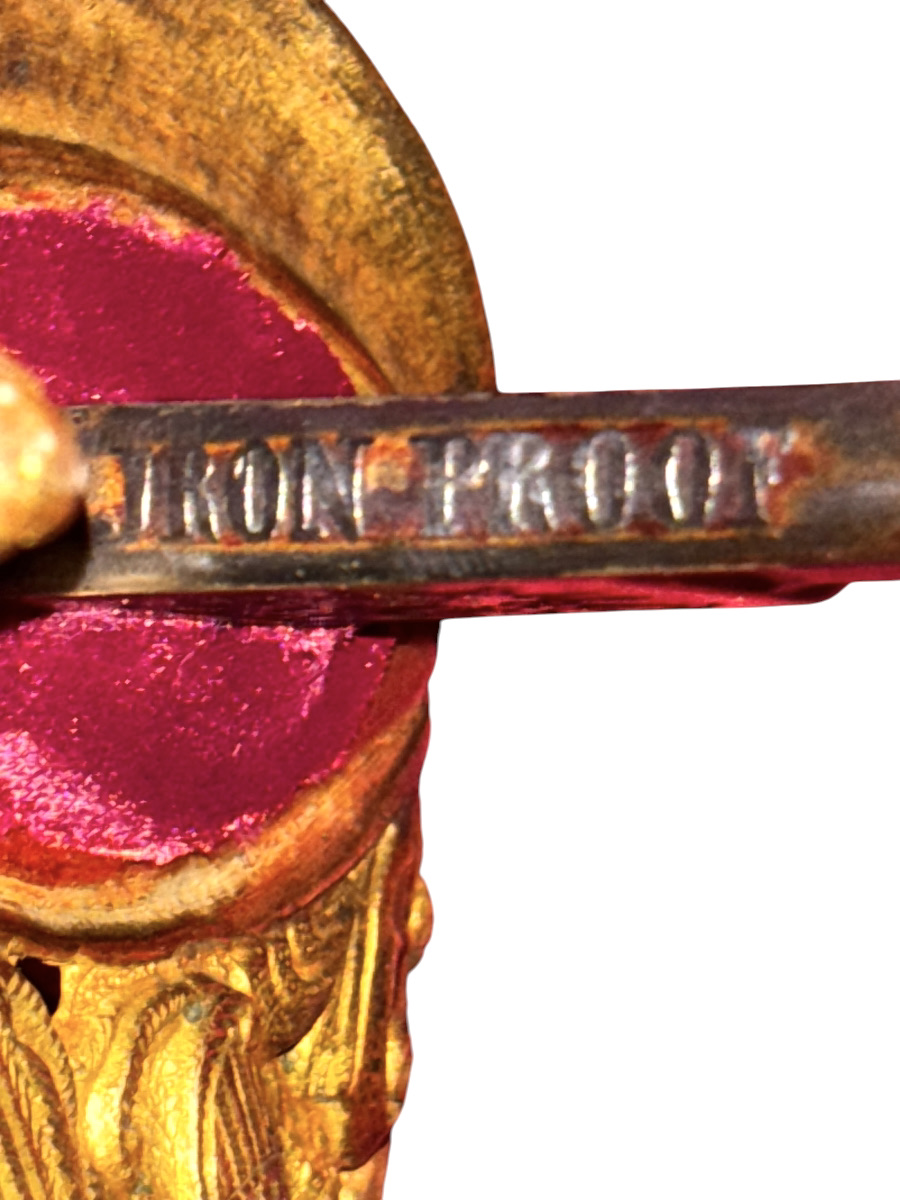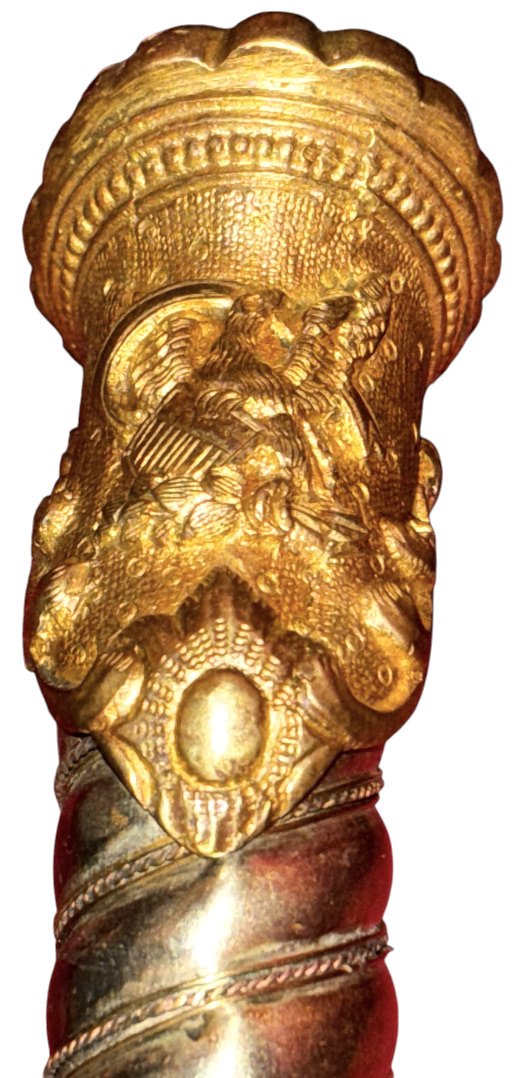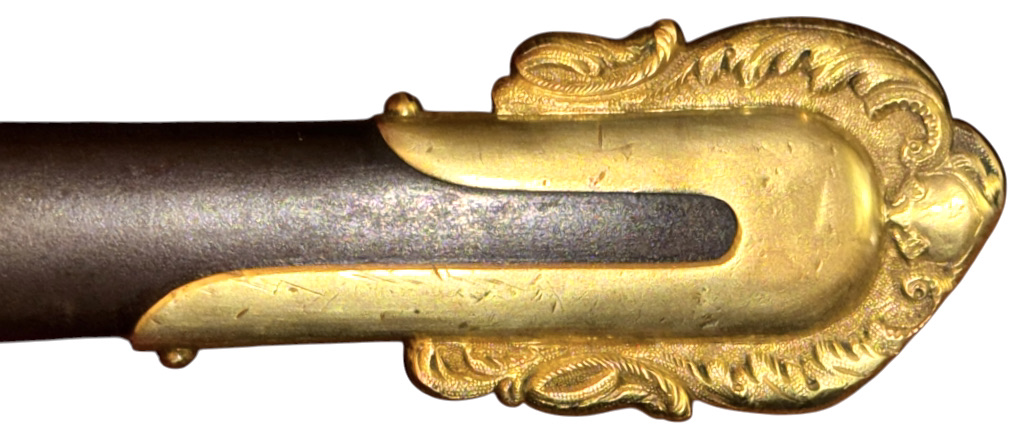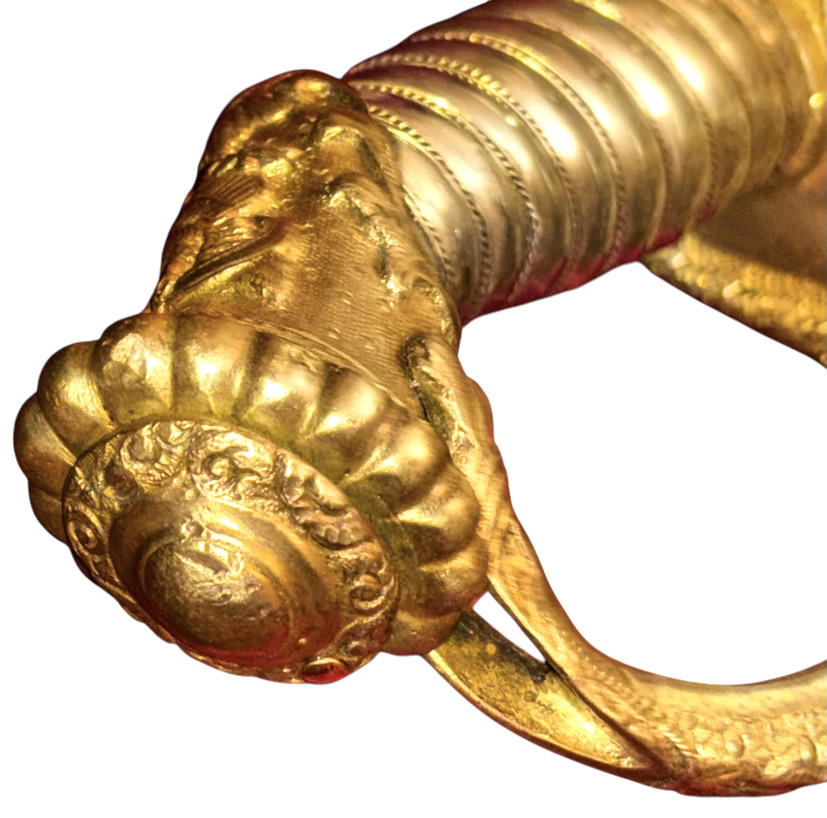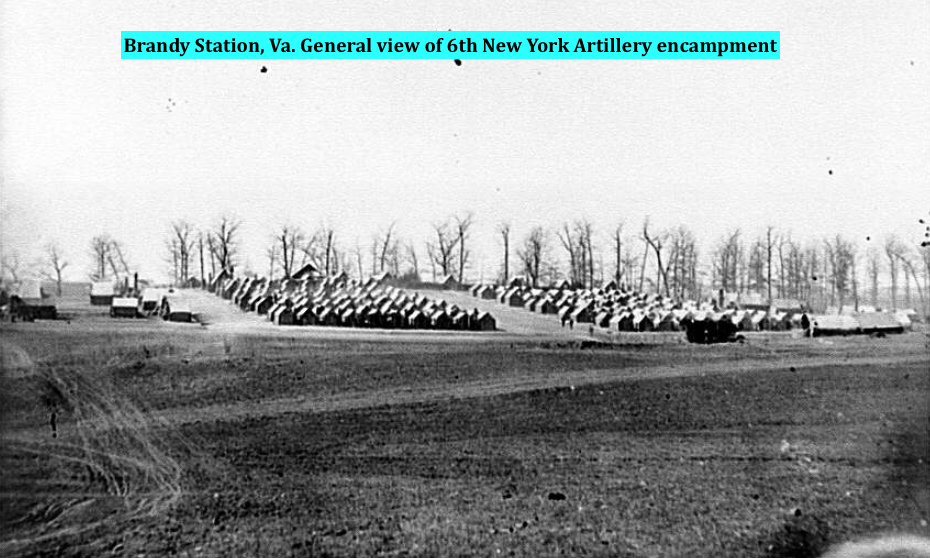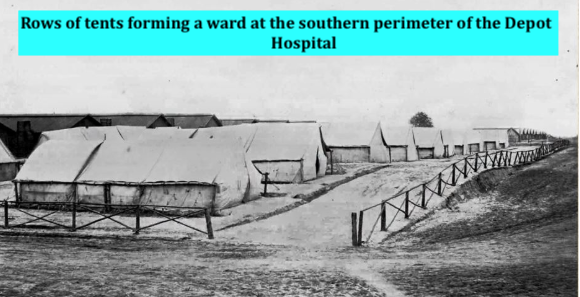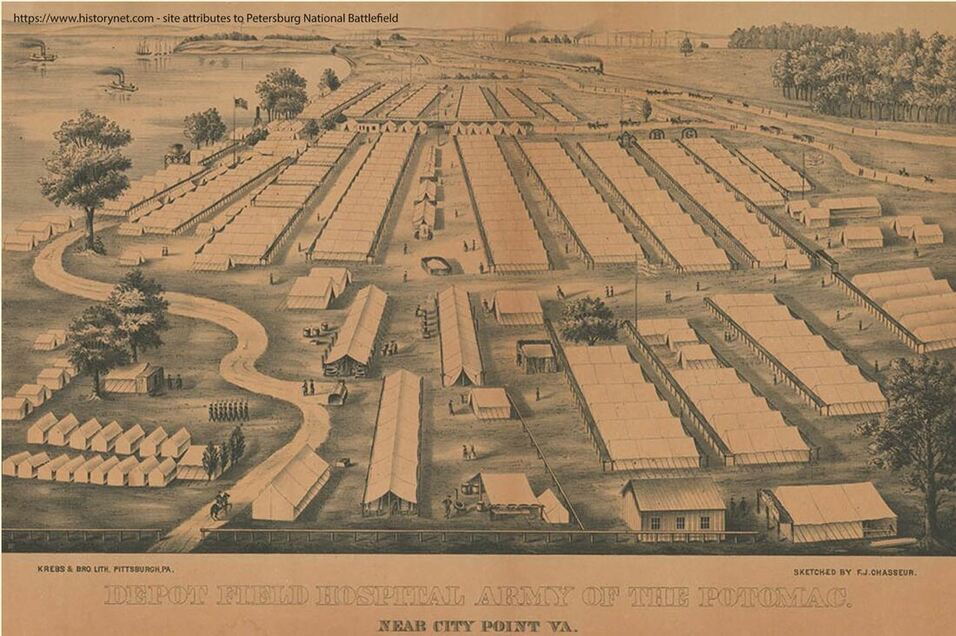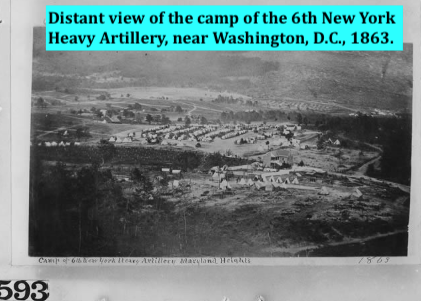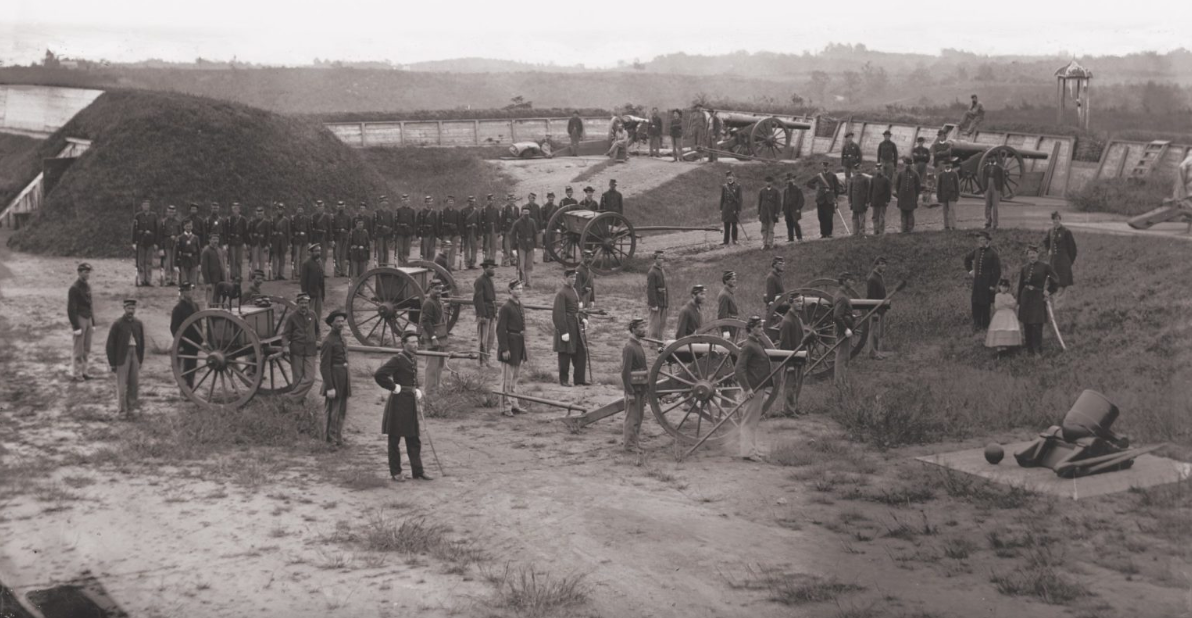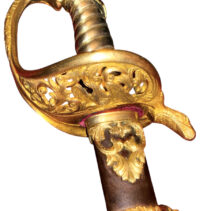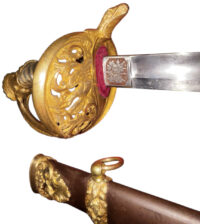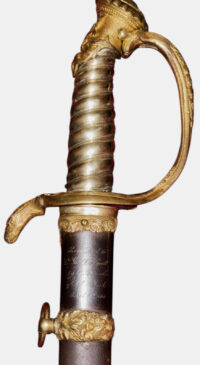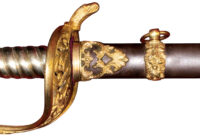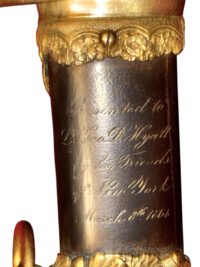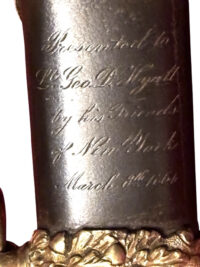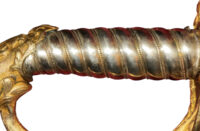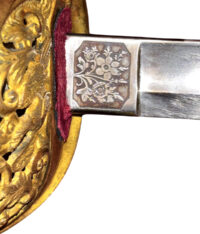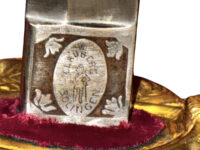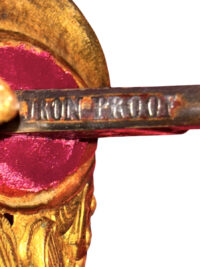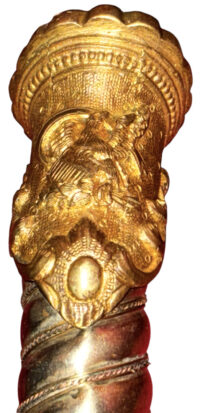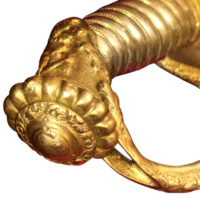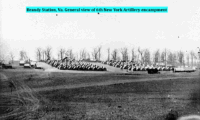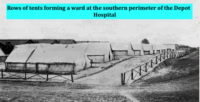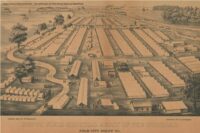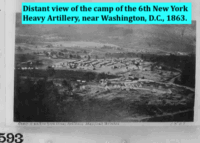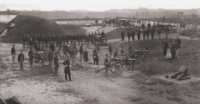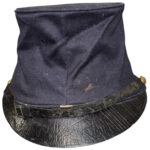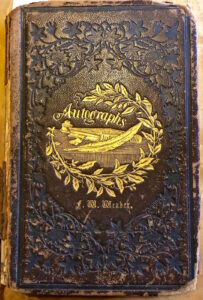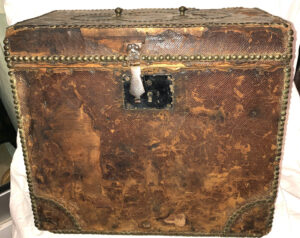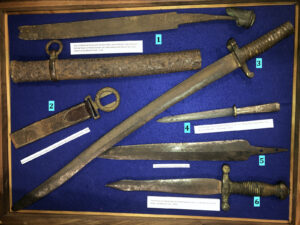Id’d Presentation Grade M1850 Foot Officers Sword – Lt. George D. Hyatt Co. E 6th NY Heavy Artillery
SOLD
Id’d Presentation Grade M1850 Foot Officers Sword – Lt. George D. Hyatt Co. E 6th NY Heavy Artillery – This is an ornately embellished example of a presentation M1850 Foot Officer’s Sword presented to Lt. George D. Hyatt of Co. E 6th New York Heavy Artillery. The sword remains in excellent condition – all of the cast brass, ornately decorative elements, exhibit patriotic and foliate designs – they retain virtually all of their original gilding; the blade, manufactured by Clauberg of Solingen, Germany, also remains in superior condition, exhibiting an American Eagle, engraved on one side of the blade and a “US” on the other side of the blade; on the spine, is the German proof mark – “IRON PROOF”; the original, red leather gasket remains in place at the entry point of the blade into the grip. The grip is constructed of ribbed, German silver and retains all of its original wire wrap. The pommel and pommel cap quite decorative; the cap is slightly loose. The scabbard is in overall excellent condition, with cast brass, highly gilded mounts and drag; there is one minor ding in the scabbard slightly above the drag. Engraved on the upper area of the scabbard, just distal to the grip, is the following:
“Presented to
Lt. George D. Hyatt
by his Friends
of New York
March 3, 1864”
Lt. Hyatt enlisted as a 2nd Lt. into Co. E of the 6th NY Heavy Artillery, in February 1864; he was commissioned on March 3, 1864, and this sword was apparently gifted to him, by friends, upon that occasion. Hyatt’s tour of duty with the 6th NY HA would be rather short in length; during his regiments’ service with the Army of the Potomac, during the Petersburg Campaign, he would die of disease in a City Point Hospital.
George D. Hyatt
Residence was not listed; 27 years old.
Enlisted on 2/29/1864 at Albany, NY as a 2nd Lieut.
On 3/15/1864, he was commissioned into “E” Co. New York 6th Heavy Artillery.
He died of disease on 7/26/1864 at City Point, VA
(Died at 2nd Division, 5th Corps Hospital)
6th NY Heavy Artillery
Organized: Yonkers, NY on 10/6/1862
Mustered out: 8/24/1865
New York SIXTH REGIMENT OF ARTILLERY (HEAVY). Anthony Wayne Guard. (Three Years) Col. Lewis G. Morris, succeeded by Col. Wm. H. Morris, received August 14, 1862, authority to recruit a regiment in the counties of Putnam, Rockland and Westchester. The regiment was organized under Col. W. H. Morris and Lieut.-Col. J. Howard Kitching, at Yonkers, as the 135th Regiment of Infantry, and there mustered in the service of the United States for three years, September 2, 1862; having been converted into an artillery regiment, it was, October 6, 1862, designated the 6th Regiment of Artillery, and two additional companies were recruited for it and mustered, December 4, 1862, in the United States service for three years; Company M was consolidated into Company A, January 26, 1864, and a new company formed of the men recruited by M. R. Pierce, for the 14th Artillery, transferred to this regiment January 13, 1864; February 2, 1864, surplus men of the 14th and 16th Artillery, about 400, were also transferred to this regiment. June 28, 1865, the men whose term of service would expire October 1, 1865, were, under the command of Col. George C. Kibbe, mustered out at Petersburg, Va.; those remaining were organized into a battalion of four companies, A, B, C and D; and there were added to them, July 19, 1865, the men not discharged at the muster-out of their regiments, of the 10th Artillery, forming Companies L, F and G, and of the 13th Artillery, forming Companies H, I, K, L and M, thus reorganizing the regiment. The original companies were recruited principally: A and F at Peekskill and Yonkers; B at Greenburgh, White Plains, Scarsdale, Harrison and Mt. Pleasant; C at West Farms; D at Somers, North Salem, Bedford and Poundridge; E at Port Chester, Harrison, New Rochelle, Mamaroneck and Rye; G at South East, Kent and Carmel; H at Morrisania; I at Ossining, New Castle, Yorktown, Cortland, Mt. Pleasant and Bedford; K at Orangetown, White Plains, West Farms, Clarkstown, Scarsdale and Greenburgh; L at Cold Springs, Carmel, Yorktown and Greenborough, at Paterson and town of Kent, N. J.; and Company M at Haverstraw, Yonkers, Somers, Poundridge, Bedford, Mt. Pleasant, North Salem and New Castle. The regiment (ten companies) left the State, September 5, 1862, and served in the Railroad Division of the 8th Corps, Middle Department, from September, 1862; Companies L and M joined it at Baltimore, Md., in December, 1862; the regiment served at Harper’s Ferry, W. Va., defenses of the Upper Potomac, from January, 1863; in the 2d Brigade, 1st Division, 8th Corps, from March 27, 1863; in the 1st Brigade, 1st Division, 8th Corps, from June, 1863; in the 1st Brigade, 3d Division, 3d Corps, Army of Potomac, from July 10, 1863; with the Reserve Artillery, Army of Potomac, as Ammunition Guard from August, 1863; in the 1st Brigade, Reserve Artillery, Army of Potomac, from April, 1864; in the Heavy Artillery Brigade, 5th Corps, from May 13, 1864; in the 3d Division, 5th Corps, from May 30, 1864; in the 3d Brigade, 2d Division, 5th Corps, from June 2, 1864; in the 1st Brigade, Harden’s Division, 22d Corps, from July, 1864; in the 1st Brigade, Kitching’s Provisional Division, Army of the Shenandoah, from September 27, 1864; in the 2d Brigade, Ferrero’s Division, Army of the James, at Bermuda Hundred, Va., from December, 1864. It served as heavy artillery and infantry. Commanded by Col. Stephen Baker, the regiment was honorably discharged and mustered out August 24, 1865, near Washington, D. C.
6th New York Heavy Artillery Regiment
| 6th Regiment New York Heavy Artillery, U.S. Volunteers | |
| Active | September 2, 1862 – October 3, 1862 (As 135th New York State Volunteers) October 3, 1862 – August 24, 1865 (As 6th New York Heavy Artillery) |
| Disbanded | August 24, 1865 |
| Country | United States |
| Allegiance | Union |
| Branch | Infantry/Artillery |
| Engagements | American Civil War |
| New York U.S. Volunteer Artillery Regiments 1861-1865 | ||||
|
| New York U.S. Volunteer Infantry Regiments 1861-1865 | ||||
|
The 6th Regiment New York Heavy Artillery, U.S. Volunteers, the “Anthony Wayne Guard”, was an artillery regiment of the Union Army during the American Civil War. It was originally mustered in as the 135th New York Volunteer Infantry Regiment, and served as both artillery and infantry.
Service
The regiment was organized under Col. William H. Morris and Lieut.-Col. J. Howard Kitching, at Yonkers, as the 135th Regiment of Infantry, and there mustered in the service of the United States for three years, September 2, 1862; having been converted into an artillery regiment, it was, October 6, 1862, designated the 6th Regiment of Artillery, and two additional companies were recruited for it and mustered, December 4, 1862, in the United States service for three years; Company M was consolidated into Company A, January 26, 1864, and a new company formed of the men recruited by M. R. Pierce, for the 14th Artillery, transferred to this regiment January 13, 1864; February 2, 1864, surplus men of the 14th and 16th Artillery, about 400, were also transferred to this regiment. June 28, 1865, the men whose term of service would expire October 1, 1865, were, under the command of Col. George C. Kibbe, mustered out at Petersburg, Virginia; those remaining were organized into a battalion of four companies, A, B, C and D; and there were added to them, July 19, 1865, the men not discharged at the muster-out of their regiments, of the 10th Artillery, forming Companies L, F and G, and of the 13th Artillery, forming Companies H, I, K, L and M, thus reorganizing the regiment.
The original companies were recruited principally:
- A and F at Peekskilland Yonkers;
- B at Greenburgh, White Plains, Scarsdale, Harrisonand Pleasant;
- C at West Farms;
- D at Somers, North Salem, Bedfordand Poundridge;
- E at Port Chester, New York, Harrison, New Rochelle, Mamaroneckand Rye;
- G at South East, Kentand Carmel;
- H at Morrisania;
- I at Ossining, New Castle, Yorktown, Cortland, Mt. Pleasant and Bedford;
- K at Orangetown, White Plains, West Farms, Clarkstown, Scarsdale and Greenburgh;
- L at Cold Springs, Carmel, Yorktown and Queensborough, at Patersonand town of Kent, New Jersey; and
- M at Haverstraw, Yonkers, Somers, Poundridge, Bedford, Mt. Pleasant, North Salem and New Castle.
The regiment (ten companies) left the State, September 5, 1862, and served in the Railroad Division of the 8th Corps, Middle Department, from September 1862; Companies L and M joined it at Baltimore, Maryland, in December 1862; the regiment served at Harper’s Ferry, West Virginia, defenses of the Upper Potomac River, from January 1863; in the 2d Brigade, 1st Division, 8th Corps, from March 27, 1863; in the 1st Brigade, 1st Division, 8th Corps, from June 1863; in the 1st Brigade, 3d Division, 3d Corps, Army of Potomac, from July 10, 1863; with the Reserve Artillery, Army of Potomac, as Ammunition Guard from August 1863; in the 1st Brigade, Reserve Artillery, Army of Potomac, from April 1864; in the Heavy Artillery Brigade, 5th Corps, from May 13, 1864; in the 3d Division, 5th Corps, from May 30, 1864; in the 3d Brigade, 2d Division, 5th Corps, from June 2, 1864; in the 1st Brigade, Harden’s Division, 22d Corps, from July 1864; in the 1st Brigade, Kitching’s Provisional Division, Army of the Shenandoah, from September 27, 1864; in the 2d Brigade, Ferrero’s Division, Army of the James, at Bermuda Hundred, Virginia, from December 1864. It served as heavy artillery and infantry.
The 6th New York Heavy Artillery was at the crossroads of many of the Civil War’s fiercest battles. Their first action occurred in December 1862 in Maryland. They guarded the Baltimore and Ohio Railroad and occasionally skirmished with Confederate sympathizers. In the summer of 1863, they marched with the Army of the Potomac and served as part of the reserves at the Battle of Gettysburg. After the battle was over, members of the regiment buried the dead.
When General Ulysses S. Grant launched his overland campaign in the spring of 1864, the 6th participated in a succession of bloody battles. These included the Battle of the Wilderness, the Battle of Spotsylvania, the Battle of Cold Harbor, the Siege at Petersburg, and the Battle of Cedar Creek, which was fought on October 19. At Cedar Creek, located in the Shenandoah Valley, the 6th were surprise attacked by the Confederates. They rallied and were able to repulse the attack thanks to the leadership of General Sheridan. Unfortunately for the 6th, Colonel J. Howard Kitching was wounded and died of his wounds on January 10. They 6th also distinguished themselves at the Battle of Harris Farm. They held their ground for over two hours and repulsed a more experienced enemy. General Gordon Meade commended the regiment “for their gallantry conduct in this affair and classing us with the Veterans of the Army of the Potomac.”
Total strength and casualties
The regiment was honorably discharged and mustered out August 24, 1865, near Washington, D. C., having during its service lost by death, killed in action, 1 officer, 62 enlisted men; of wounds received in action, 5 officers, 68 enlisted men; of disease and other causes, 6 officers, 278 enlisted men; total, 12 officers, 408 enlisted men; aggregate, 420; of whom 57 enlisted men died in the hands of the enemy.
Commanders
- Colonel William H. Morris– promoted to Brigadier General
- Colonel Howard Kitching– mortally wounded
- Colonel George C. Kibbe
- Colonel Stephen D. Baker
6th Heavy Artillery Regiment
Nickname: Anthony Wayne Guard
Mustered in as the 135th regiment of infantry: September 2, 1862.
Designated 6th regiment of heavy artillery: October 3,1862.
Mustered out: August 24, 1865.
The following is taken from New York in the War of the Rebellion, 3rd ed. Frederick Phisterer. Albany: J. B. Lyon Company, 1912.
Col. Lewis G. Morris, succeeded by Col. Wm. H. Morris, received August 14, 1862, authority to recruit a regiment in the counties of Putnam, Rockland and Westchester. The regiment was organized under Col. W. H. Morris and Lieut.-Col. J. Howard Kitching, at Yonkers, as the 135th Regiment of Infantry, and there mustered in the service of the United States for three years, September 2, 1862; having been converted into an artillery regiment, it was, October 6, 1862, designated the 6th Regiment of Artillery, and two additional companies were recruited for it and mustered, December 4, 1862, in the United States service for three years; Company M was consolidated into Company A, January 26, 1864, and a new company formed of the men recruited by M. R. Pierce, for the 14th Artillery, transferred to this regiment January 13, 1864; February 2, 1864, surplus men of the I4th and 16th Artillery, about 400, were also transferred to this regiment. June 28, 1865, the men whose term of service would expire October I, 1865, were, under the command of Col. George C. Kibbe, mustered out at Petersburg, Va.; those remaining were organized into a battalion of four companies, A, B, C and D; and there were added to them, July 19, 1865, the men not discharged at the muster-out of their regiments, of the 10th Artillery, forming Companies L, F and G, and of the 13th Artillery, forming Companies H, I, K, L and M, thus reorganizing the regiment.
The original companies were recruited principally: A and F at Peekskill and Yonkers; B at Greenburgh, White Plains, Scarsdale, Harrison and Mt. Pleasant; C at West Farms; D at Somers, North Salem, Bedford and Poundridge; E at Port Chester, Harrison, New Rochelle, Mamaroneck and Rye; G at South East, Kent and Carmel; H at Morrisania; I at Ossining, New Castle, Yorktown, Cortland, Mt. Pleasant and Bedford; K at Orangetown, White Plains, West Farms, Clarkstown, Scarsdale and Greenburgh; L at Cold Springs, Carmel, Yorktown and Greenborough, at Paterson and town of Kent, N. J.; and Company M at Haverstraw, Yonkers, Somers, Poundridge, Bedford, Mt. Pleasant, North Salem and New Castle.
The regiment (ten companies) left the State, September 5, 1862, and served in the Railroad Division of the 8th Corps, Middle Department, from September, 1862; Companies L and M joined it at Baltimore, Md., in December, 1862; the regiment served at Harper’s Ferry, W. Va., defenses of the Upper Potomac, from January, 1863; in the 2d Brigade, 1st Division, 8th Corps, from March 27, 1863; in the 1st Brigade, 1st Division, 8th Corps, from June, 1863; in the 1st Brigade, 3d Division, 3d Corps, Army of Potomac, from July 10, 1863; with the Reserve Artillery, Army of Potomac, as Ammunition Guard from August, 1863; in the 1st Brigade, Reserve Artillery, Army of Potomac, from April, 1864; in the Heavy Artillery Brigade, 5th Corps, from May 13, 1864; in the 3d Division, 5th Corps, from May 30, 1864; in the 3d Brigade, 2d Division, 5th Corps, from June 2, 1864; in the 1st Brigade, Harden’s Division, 22d Corps, from July, 1864; in the 1st Brigade, Kitching’s Provisional Division, Army of the Shenandoah, from September 27, 1864; in the 2d Brigade, Ferrero’s Division, Army of the James, at Bermuda Hundred, Va., from December, 1864. It served as heavy artillery and infantry.
Commanded by Col. Stephen Baker, the regiment was honorably discharged and mustered out August 24, 1865, near Washington, D. C., having during its service lost by death, killed in action, 1 officer, 62 enlisted men; of wounds received in action, 5 officers, 68 enlisted men; of disease and other causes, 6 officers, 278 enlisted men; total, 12 officers, 408 enlisted men; aggregate, 420; of whom 57 enlisted men died in the hands of the enemy.
The following is taken from The Union army: a history of military affairs in the loyal states, 1861-65 — records of the regiments in the Union army — cyclopedia of battles — memoirs of commanders and soldiers, Volume II: New York, Maryland, West Virginia and Ohio. Madison, WI: Federal Pub. Co., 1908.
Sixth Artillery (Heavy).—Cols., William H. Morris, J. Howard Kitching, George C. Kibbe, Stephen D. Baker; Lieut. -Cols., J. Howard Kitching, Ralph E. Prime, Edward R. Travis, Edward B. Williston, James B. Campbell, George C. Kibbe, Stephen D. Baker; Majs., J. H. Robinson, Edward R. Travis, Frederick Shonnard, James B. Campbell, Absalom A. Crookston, George C. Kibbe, Stephen D. Baker, Edmund Y. Morris, Ferd. R. Hassler, C. H. Palmer, Edward Jones. This regiment, known as the Anthony Wayne Guard, was recruited in the summer of 1862 in the counties of Putnam, Rockland and Westchester. It was organized at Yonkers as the 135th infantry and was there mustered into the U. S. service for three years, Sept. 2, 1862. It was converted into an artillery regiment in October and designated the 6th regiment of artillery, two additional companies recruited for it being mustered in on Dec. 4. After the consolidation of Co. M and Co. A in Jan., 1864, a new Co. M, composed of men recruited by M. R. Pierce for the 14th N. Y. artillery, was transferred to it, and in Feb., 1864, about 400 of the surplus men of the 14th and i6th artillery were also transferred to this regiment. On June 28, 1865, the men whose terms would expire on Oct. i, were mustered out at Petersburg, under command of Col. Kibbe, the veterans and recruits being formed into a battalion of four companies. On July 19, 1865, the remaining members of the loth and 13th artillery were transferred to this battalion, and this consolidated force was mustered out on Aug. 24, near Washington, D. C, under command of Col. Baker. The regiment— ten companies—left the state on Sept. 5, 1862, and Cos. L and M joined it at Baltimore in December. It served with the 8th corps at Harper’s Ferry and in the defenses of the Upper Potomac until July, 1863, when it was attached to the 1st brigade, 1st division, 3d corps, and in August, to the reserve artillery, Army of the Potomac, employed as ammunition guard. It took part in an action at Manassas gap in July, 1863, and in the Mine Run campaign in November. Then, as infantry and heavy artillery, it served until July, 1864, with the 5th corps. Army of the Potomac, being active in all the battles leading up to the investment of Petersburg, including the Wilderness, Spottsylvania, where its casualties amounted to 18 killed, 131 wounded and 6 missing, the North Anna, where it lost 17 killed, 99 wounded and 17 missing, Totopotomy, Cold Harbor, and the assault on Petersburg in June, with a loss of 92. In July it was attached to the 1st brigade, Hardin’s .division, 22nd corps, and in August was ordered to Washington for garrison duty, remaining there for five weeks, when it was ordered to join the Army of the Shenandoah, attached to the 1st brigade, Kitching’s provisional division, and later to the 2nd brigade, Ferrero’s division. Army of the James, at Bermuda Hundred. In the battle of Cedar creek it was heavily engaged, losing 94 killed, wounded and missing, both Col. Kitching and Maj. Jones being mortally wounded. It was present at the fall of Petersburg on April 2, 1865. The regiment lost by death during service 6 officers and 130 men killed and mortally wounded; 6 officers and 278 men died of disease, accident, in prison, etc., a total of 420.
6th Regiment Artillery (Heavy), NY Volunteers | Flank Markers | Civil War
The 6th Regiment Artillery, New York Volunteers, mustered into service for three years as the 135th New York Volunteer Infantry on September 2, 1862.…
6th Regiment, New York Heavy Artillery
Overview:
Organized at Yonkers, N. Y., as the 135th Regiment Infantry, and mustered in September 2, 1862. Designation changed October 3, 1862. Left State for Baltimore, Md., September 5, 1862. Attached to Defences of Baltimore, Md., 8th Army Corps, Middle Department, to January, 1863. Defences. Upper Potomac, to March, 1863. 2nd Brigade, 1st Division, 8th Army Corps, to June, 1863. 3rd Provisional Brigade, French’s Division, 8th Army Corps, to July, 1863. 1st Brigade, 3rd Division, 3rd Army Corps, to August, 1863. Artillery Reserve and Headquarters and ammunition train guard, Army of the Potomac, to April, 1864. 1st Brigade, Artillery Reserve, Army of the Potomac, to May 13, 1864. Kitching’s Heavy Artillery Brigade, 5th Army Corps, Army of the Potomac, to May 30, 1864. 1st Brigade, 3rd Division, 5th Army Corps, to June 2, 1864. 3rd Brigade, 2nd Division, 5th Army Corps, to August, 1864. 1st Brigade, Hardin’s Division, 22nd Army Corps, Dept. of Washington, to September, 1864. 1st Brigade, Kitching’s Provisional Division, Middle Military Division, September 27 to December 3, 1864. 2nd Brigade, Provisional Division, Army of the James, and 2nd Brigade, Infantry Division, Defences of Bermuda Hundred, Army of the James, to March 1865. 2nd Brigade, Ferrero’s Division, Dept. of Virginia, to May, 1865. Sub-District of Roanoke, District of the Nottaway, Dept. of Virginia, to August, 1865.
Service:
Duty at Fort McHenry, Baltimore, Md., to December, 1862. Companies “B,” “E,” “F,” “I” “L” and “M”). Companies “A,” “C,” “D,” “G,” and “K” at Harper’s Ferry, W. Va., December, 1862. Duty on the Upper Potomac till July, 1863. Pursuit of Lee July. Wapping Heights, Va., July 23. Ammunition train guard for Army of the Potomac till April, 1864. Bristoe Campaign October 9-22, 1863. Advance to line of the Rappahannock November 7-8. Mine Run Campaign November 26-December 2. Rapidan Campaign May-June, 1864. Battles of the Wilderness May 5-7. Spottsylvania May 8-12. Spottsylvania Court House May 12-21. Harris Farm (or Fredericksburg Road) May 19. North Anna River May 23-26. On line of the Pamunkey May 26-28. Totopotomoy May 28-31. Cold Harbor June 1-12. Bethesda Church June 3. Before Petersburg June 16-18. Siege of Petersburg June 16-July 9. Ordered to Washington, D. C., and duty in the Defences of that city till September. Sheridan’s Shenandoah Valley Campaign September to December. Battle of Cedar Creek October 19. Duty in the Shenandoah Valley till December. Moved to Bermuda Hundred, Va., and duty in the Defences at that point till March, 1865. Fort Brady January 24, 1865. Appomattox Campaign March 28-April 9. Fall of Petersburg April 2. Duty in the Sub-District of Roanoke, District of the Nottaway, Dept. of Virginia, till June, and at Petersburg, Va., till August. Mustered out near Washington, D. C., August 24, 1865.
Regiment lost during service 5 Officers and 130 Enlisted men killed and mortally wounded and 6 Officers and 275 Enlisted men by disease. Total 417.
Predecessor units:
NEW YORK VOLUNTEERS
172nd REGIMENT INFANTRY.
Failed to complete organization. Men enlisted transferred to 6th New York Heavy Artillery.
NEW YORK VOLUNTEERS
135th REGIMENT INFANTRY (“ANTHONY WAYNE GUARD”).
Organized at Yonkers, N. Y., and mustered in September 2, 1862. Left State for Baltimore, Md., September 5, 1862. Designation of Regiment changed to 6th New York Heavy Artillery October 3, 1862.

